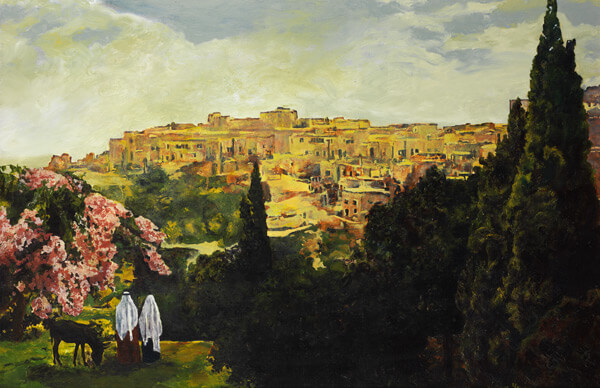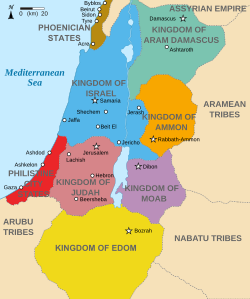
The fight for
Jerusalem has been ongoing for thousands of years, and one of the most sought after cities in the world. The city's beginning dates back to the
B.C. Era and has had its fair share of battles and skirmishes, which often resulted in the downfall and rebirth of the city.
One of the oldest cities in the world today, Jerusalem is considered sacred to the three
Abrahamic religions -
Judaism,
Christianity, and
Islam. To better understand this sacred city's appeal, we need to start from the beginning...
Name "Jerusalem" Originated From...
The word "Jerusalem" is etymologized to mean "foundation of the god Shalim"; the god
Shalim (or Shalem) was the original
tutelary deity of the Bronze Age city. In the
Canaanite religion of antiquity, from where this polytheistic god originates, Shalim was the name of the god of dusk. His name is based on the same root
Š-L-M from which the Hebrew word for "peace" is derived. Many variations of the name includes Salam (Arabic) and Shalom (Hebrew). In Arabic, Jerusalem is most commonly known as al-Quds, meaning "The Holy" or "The Holy Sanctuary".

According to some scholars, the oldest part of the current city was believed to have been originally inhabited around 4000 B.C. during the time of the antediluvian biblical characters such as Adam, Cain, Enoch, Methuselah and Noah.
As early as the 19th century B.C. there was a city called Rušalim, according to the Execration texts of the Middle Kingdom of Egypt, and many scholars identify this with Jerusalem.
The Amarna letters of Abdi-Heba (dated 1330s B.C.) classify Jerusalem as Urušalim and, according to the Bible, this most ancient settlement (founded during the Bronze Age) was named Jebus. During the reign of
King David (c/1010-970 B.C.), this holy metropolis became known as the
City of David; this was the most common name associated with the city during antiquity.
After the
Assyrian siege and the
Babylonian captivity, the city became commonly known as Jerusalem and has since remained its burghal title.
According to biblical tradition, King David conquered the ancient city of Jerusalem from the Jebusites and established it as the capital of the
United Kingdom of Israel.
 |
| Unto The City of David by Ashton Young |
By 930 B.C., the united kingdom divided and became known as the
Kingdom of Israel and the
Kingdom of Judah, with Judah retaining Jerusalem as its capital. The oldest part of the modern city was settled around the 4th century B.C.
After Jewish captivity, King David's holy city went through a succession of sovereignty, starting with the
Babylonian empire.
Overview of Jerusalem's historical periods
Modern History of Jerusalem

During the birth of the
Christian Era, in the 1st century A.D., the holy city took on a whole new meaning for the word "beginning". For the Christians, their beginning started with the birth and
ministry of Jesus, giving Jerusalem great importance, which was foretold in the Old Testament (
Hebrew Bible).
According to the
Canonical gospels, Jerusalem was the city to which
Joseph and Mary brought Jesus as a child, to be presented at the Temple (
Luke 2:22) and to attend the festivals (
Luke 2:41). The Christian Messiah preached and healed in this sacred city, as well as performed the "mikvaot" (
baptismals). The events of
Pentecost, recorded in the
Acts of the Apostles, also took place within the ancient city. According to
Mark the Evangelist, Jesus' cleansing of the
Temple at the Temple Court and chasing various traders out of the sacred precincts also occurred in Jerusalem (
Mark 11:15). At the end of the four Gospels, there are accounts of Jesus'
Last Supper in an "upper room" in Jerusalem, his arrest at
Gethsemane, his trial and crucifixion [at
Golgotha], his burial, as well as his resurrection and accension. The
Apostolic Age ushered in one of Jerusalem's most noteworthy periods during her thus long history.

Jerusalem is held sacred in Muslim tradition, as well. According to the Qur'an, the
prophet Muhammad was taken by a miraculous steed named Buraq to visit the Farthest Mosque (which many Muslims believe is the Al Aqsa Mosque in Jerusalem), and there he prayed, and was then taken to heaven, in a single night in the year 620 A.D.
During this nightly event, Buraq took him to the heavens, where the Islamic prophet toured the seven stages of heaven, and met with Abraham, Moses and Jesus. In Islamic tradition, this event is known as
Isra wal Mi'raj, . Many Islamic scholars believe this event took place on the Temple Mount, where the Al Aqsa Mosque is presently located.
During the
Crusades in the
A.D. era, the city was overtaken by the Christians (between 1095-1291) and controlled for the next 200 years. It was one of Jerusalem's most horrific times during its long history.
 |
| Osman I |
While Jerusalem went through many dominions, the
Roman Empire controlled the city the longest until
Osman I captured it in 1299 A.D. (This would later become known as the Ottoman Empire).
For over 600 years, the
Ottoman Empire ruled over the ancient holy city (1299-1918), but never made Jerusalem its capital. This Sunni Islamic state was founded by
Oghuz Turks under the reign of Osman I in northwestern Anatolia around 1299 and grew to its height of power under the rule of
Suleiman the Magnificent during the 16th century.
Following a long period of military setbacks against European powers and its gradual decline, the Ottoman Empire collapsed and was dissolved in the aftermath of
World War I. From this downfall, the country of Turkey was born and the city of Jerusalem became a territory of Britain. It was during British rule that Jews were allowed to return to Jerusalem... the first time in over 2,500 years!
By 1948, the
State of Israel was established by a mandate from the United Nations when Britain dissolved its territorial ownership. The influx of Jews so began and by 1958 over two million Jews were living in the State of Israel. [These Jewish immigrants came to Israel for differing reasons - some believed in the
Zionist movement, while others moved to escape horrid persecution.] During the first Arab-Israeli War in 1948, West Jerusalem was captured and later annexed by Israel. East Jerusalem, which included the Old City, was captured and annexed by
Jordan.
 |
| Buffalo Soldiers by Johnny Schumate |
The
Six-Day War (June 5-June 10, 1967) came about when Israel launched a pre-emptive strike against Egypt, Jordan, Syria and Iraq when those Arab states began to mobilize their forces to invade the small country. The end result was Israel succeeding in capturing the West Bank, the Gaza Strip, Sinai Peninsula and the Golan Heights. Jerusalem's boundaries had been enlarged during that time era, as well. It was during the Six Day War, Israel captured East Jerusalem from Jordan, ending Jordan's short occupation of the sacred city in 1967.
Today, modern Jerusalem has grown far beyond the
Old City's boundaries. While Israel has claimed rightful status of Jerusalem's dominion for almost 48 years, Israeli sovereignty over Jerusalem is not recognized internationally.
~*~*~*~*~*~*~*~*~*~*~*~*~*~*~*~*~
During its long history, Jerusalem has been destroyed at least two times (8th century B.C. and 1st century A.D), besieged 23 times, attacked 52 times, and captured and recaptured 44 times. Today, Israel and
Palestine both claim Jerusalem as their capital; Israel maintains its primary governmental institutions there and Palestine ultimately foresees the city as its seat of power. However, neither claim is widely recognized internationally.
In 2017, the United Nations resumed peace talks concerning a Palestinian State, which once more has put the city of Jerusalem in the line of fire and again finds itself in an oppressing conflict that has captured the world’s attention.









